Scoring the Line
“Pegging”, or scoring during a player’s turn
Scoring occurs both during the round and at the end of a round. During the round, players score points at the end of their turn by playing cards on the line, commonly called ‘pegging’. Scoring the round occurs at the end of the round and consists of each of the players scoring their hands and the dealer also gets to score an additional hand called the crib.
Any points the player fails to peg on the cribbage board are forfeited once the subsequent player pegs their next point.
Any points the player fails to peg on the cribbage board are forfeited once the subsequent player pegs their next point.
Scoring the Line
Scoring the line is performed at the end of every turn. The total number of points earned is equal to the sum total of the points scored for the following items: the sum of the line equaling 15 or 31; unique pairs; unique runs; combination of unique pairs and runs; placing the common card; and Knobs. A player will also score a point whenever the line is renewed.
Sum of the Line Equaling 15 or 31
The player will score 2 points whenever they place a card on the line and the ranks of the cards sum to 15 or 31 points.
Example
The top example shows the line sums to 15 points, the lower example sums to 31 points. Both earn the Player 2 points.
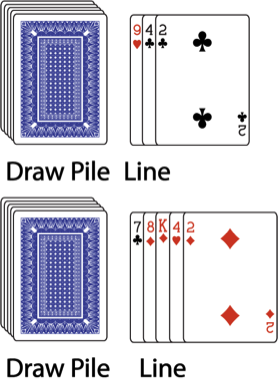
Uniquie Pairs
The player will score 2 points for every unique pair that is adjacent in the line and one of the cards is the last card on the line. Three and four of kind scores 2 points for each unique pair and is considered as a group, adjacency is not required.
Example
The top example scores no points for the two queens placed on the line. The queens are not adjacent, and are not a part of a run, so they do not score.
The middle example, 3 of a kind, scores 6 points because the there are three unique pairs (for 2 points each) which are 6d & 6s, 6s & 6c and 6c & 6d.
The bottom example scores 12 points, because there are 4 of a kind. In a 4 of a kind there are 6 unique pairs each worth 2 points for 12 points total, just like the middle example. 2h & 2s, 2h & 2c, 2h & 2d, 2s & 2c, 2s & 2d, 2c & 2d.
The middle example, 3 of a kind, scores 6 points because the there are three unique pairs (for 2 points each) which are 6d & 6s, 6s & 6c and 6c & 6d.
The bottom example scores 12 points, because there are 4 of a kind. In a 4 of a kind there are 6 unique pairs each worth 2 points for 12 points total, just like the middle example. 2h & 2s, 2h & 2c, 2h & 2d, 2s & 2c, 2s & 2d, 2c & 2d.
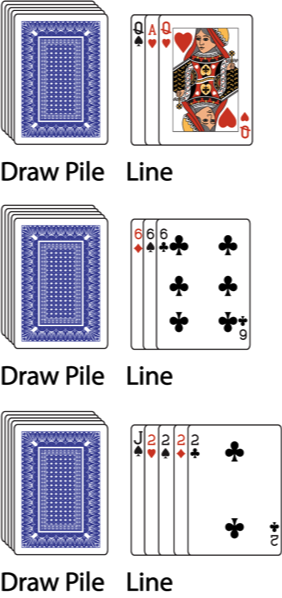
Unique Runs
Using up to the last 5 cards placed on the line, the player scores 1 point for each card in a run of consecutive ranked cards. The order of the cards is not important but the runs need to be started from the last card placed and must be adjacent cards. Ace is low and cannot be included in a run with a face card.
Example
The run in the top example scores 3 points. The cards do not need to be in order.
The run in the middle example scores 4 points.
The run in the bottom example scores 5 points. Even though there is a 6-card run only the last five cards can be counted.
The run in the middle example scores 4 points.
The run in the bottom example scores 5 points. Even though there is a 6-card run only the last five cards can be counted.
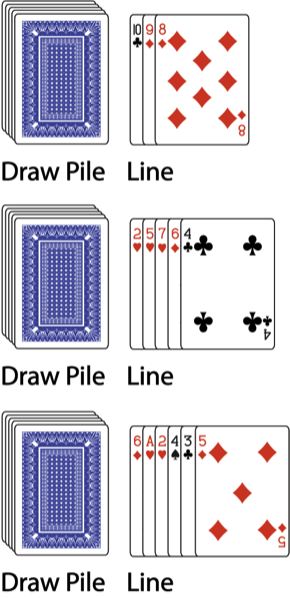
Combination of Unique Pairs and Runs
Using up to the last 5 cards placed on the line runs and pairs are combined for scoring. This is a special case for scoring runs and pairs. The pairs do not need to be adjacent cards, and the cards in the run do not need to be in order, but they must be contained within the last 5 cards placed on the line.
Example
The top example scores 8 points. The last four cards contain two unique runs of 3 cards and a pair. The first run, for 3 points is 4s-5d-6s. The second run, for 3 points is 4s-5s-6s. 5d-5d forms the pair for 2 points.
The bottom example scores 16 points. The last five cards contain four unique runs of 3 cards and two pairs. The runs include 3c-4c-5h, 3d-4c-5h, 3c-4d-5h, 3d-4d-5h. There are two pairs of 3c-3d and 4c-4.d The 2s is not included in the scoring because it is the sixth card.
The bottom example scores 16 points. The last five cards contain four unique runs of 3 cards and two pairs. The runs include 3c-4c-5h, 3d-4c-5h, 3c-4d-5h, 3d-4d-5h. There are two pairs of 3c-3d and 4c-4.d The 2s is not included in the scoring because it is the sixth card.
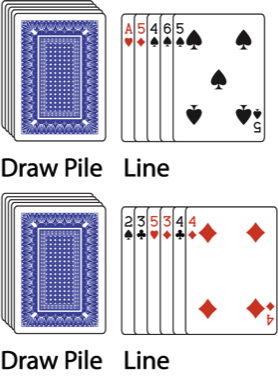
Placing the Common Card
The player who places last card on the line ending a round, which is called the common card, will score 1 point.
Knobs (for the Dealer)
The dealer, and only the dealer, will score two points if the last card played on the line, or common card, is a jack, which in cribbage is called ‘Knobs’. It does not matter which player is placing the common card. Dealer scores Knobs after the player placing the common card pegs their points.
Renewing the Line or “Go”
One point is scored by the player to the right of the current player whenever the line is renewed. A line is renewed when the current player places a card on the line that causes it to exceed 31 points. This is referred to as a ‘Go’.
Examples
Look at the examples below and see if you can score them on your own.
Example 1
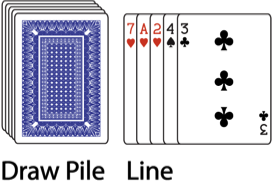
This example scores 4 points for a 4-card run.
Example 2
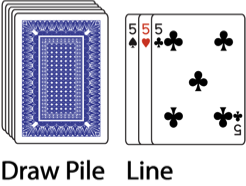
This example scores 8 points. 2 points for the sum of the line equaling 15. 6 points for the 3 of a kind (which consists of 3 unique pairs).
Example 3
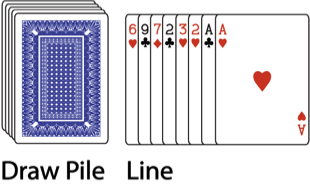
This example scores 18 points. 2 points for the sum of the line equaling 31, 4 points for pairs found in the last 5 cards on the line. 12 points for four unique runs found in the last 5 cards on the line. The pairs and runs can be counted because they occurred in the last 5 cards under the combination of runs and pairs scoring rule.
